2001 Rolex 24 Hours of Daytona
 The Unofficial title of the event: "Corvette Heaven"
The Unofficial title of the event: "Corvette Heaven"
It is always a long winter for race fans, but for many reasons this one has been excruciating. Maybe it was the 17 straight days of sub-freezing weather before January 1, which for Ohio is pretty darn frigid. Perhaps, it was the 600 bazillion tons of salt that was on the roads for next 17 days.
Then there is my lovely wife of eight years who is suffering from TOP Syndrome (Tired of Pregnancy). Before all of the ladies start throwing rocks I love her, I support her, and she herself admits that she is tired of winter and being pregnant, and misses racing and is due March 19 for anyone interested in these types of things.
Back to the mission. My company has been lucky enough to do some sports marketing for racing teams, including a Ferrari 333SP team in the Grand Am series, and hence the idea was hatched to go to Daytona for a few short meetings and a lot of being a race fan. Since I am the consummate professional, I refrained from kissing the client on the lips, a relief to everyone, and quietly and quickly reorganized my life to take advantage of this incredible opportunity.
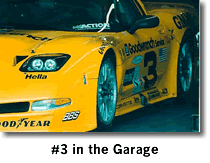 Flights were dirt cheap, and painless, and flying into Daytona International (I think the only international flight is from Canada) is Step One in the ultimate car guy experience called the Rolex 24 Hours. For those who have not had the fortune of dropping into the airport, the runway runs parallel to the back straight of the speedway, and it appears for a few moments like the pilot has gotten the urge to attempt a qualifying lap while on approach. I love this airport. Maybe 20 gates in total, racecar pictures everywhere, one of "dem" stock car racers (the MBNA Winston Cup car) in baggage claim more car guy heaven and lots of friendly, bored retired folks to smile and point you anywhere you please.
Flights were dirt cheap, and painless, and flying into Daytona International (I think the only international flight is from Canada) is Step One in the ultimate car guy experience called the Rolex 24 Hours. For those who have not had the fortune of dropping into the airport, the runway runs parallel to the back straight of the speedway, and it appears for a few moments like the pilot has gotten the urge to attempt a qualifying lap while on approach. I love this airport. Maybe 20 gates in total, racecar pictures everywhere, one of "dem" stock car racers (the MBNA Winston Cup car) in baggage claim more car guy heaven and lots of friendly, bored retired folks to smile and point you anywhere you please.
Weather was not what I was hoping for, nor what the Weather Channel had predicted, but 60 degrees was plenty warm enough for me. The rental sled does not even get warmed up, and the seat belt idiot bell, barely quits dinging in the short drive to the speedway, right down Richard Petty Way.
Hats off to the Grand Am organizers who issued our pit credentials in less than 10 minutes and got us to our final destination the infield. We did make the small investment ($15) for two-day grandstand tickets from the speedway office so we could watch the start and finish from the steep seats, but make no bones about it, the place to be is inside of the 3.56 mile circuit’s infield.
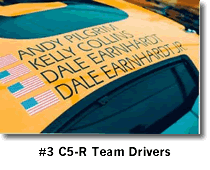 Friendly old timers, wave you in and yell welcome to Daytona as you drive into the steep turn 4 tunnel, then a blast of daylight and the first visions of the Race Fan Base Camp. It comes complete with huts made from two by fours and tarps built in the back of pick up trucks, small camp fires burning, flags waving in the rather cool and stiff breeze, pup tents, smoke in the air, and lots and lots of cars. Wonderful cars.
Friendly old timers, wave you in and yell welcome to Daytona as you drive into the steep turn 4 tunnel, then a blast of daylight and the first visions of the Race Fan Base Camp. It comes complete with huts made from two by fours and tarps built in the back of pick up trucks, small camp fires burning, flags waving in the rather cool and stiff breeze, pup tents, smoke in the air, and lots and lots of cars. Wonderful cars.
I lost count of Corvettes before we even parked the car. Dozens and dozens of C4 and C5 Corvettes were assembling to support the C5R Corvette Racing Team.
Only a few hundred yards into the speedway on the right side of the access road, is the racing paddock, and for the Rolex weekend, a group of food vendors, stages, displays, and car shows and auctions to rival most county fairs. But the crown jewel for me was the Corvette Heritage Tour display, located right at a major crossroads in the paddock.
It was our first stop. While I was interested in the unrestored 1953, the C3 prototype racecar, a 327 and 427 on engine stands, I just could not take my eyes off of the stars of the tent, a yellow Z06 and last year’s C5R racecar in 2001 livery. What a phenomenal machine. Next to it was the heart of the beast, the seven liter, yes I said seven liter, C5R engine (that’s 427 fuel-injected cubic inches of race tuned aluminum) displayed on a stand.
Here are some quick specs on the C5-R in comparison to the production C5 (2000):
| Stock 2000 Corvette | 2000 Corvette C5-R | |
|---|---|---|
| Wheelbase | 104.5 in. | 104.7 in. |
| Length | 179.7 in. | 182.8 in. |
| Width | 73.6 in. | 76.4 in. |
| Height | 47.7 in. | 45.8 in. |
| Front Tread | 62.1 in. | 74.7 in. |
| Rear Tread | 62.2 in. | 76.1 in. |
| Curb Weight | 3245 lbs. | 2510 lbs. |
| Fuel Capacity | 18.5 gals. (US) | 100 liters |
| Width | 73.6 in. | 76.4 in. |
| Structure | Both steel welded frames with hydroformed frame rails | |
| Body | Fiberglass Reinforced Plastic | Carbon Fiber |
| Tires Front | P245/45ZR-17 Goodyear Eagle F-1 high performance Extended Mobility (EMT) | Goodyear Racing Eagle 25X12-18 |
| Tires Rear | P275/40ZR-18 Goodyear Eagle F-1 high performance Extended Mobility (EMT) | Goodyear Racing Eagle 28X14-18 |
| Wheels Front | 17" X 8.5" 5-spoke aluminum | BBS forged magnesium 1 piece center lock wheel |
| Wheels Rear | 18" X 9.5" 5-spoke aluminum | BBS forged magnesium 1 piece center lock wheel |
| Front Brake Rotor (Diameter/Thickness) | 12.6 in. / 1.26 in. | 15.0 in. / 1.38 in. |
| Rear Brake Rotor | 11.8 in. / 1.0 in. | 14.0 in. / 1.26 in. |
| Total Sweep Area F/R | 263 sq. in./158 sq. in. | 343 sq. in./292 sq. in. |
| Engine Type | LS1 Pushrod V8 with aluminum block and heads | LS1 Pushrod V8 with aluminum block and heads |
| Bore/Stroke/CID | 3.90 x 3.62 / 5.67 liters (346 CID) | 4.124 x 4.00 / 6.98 liters (427 CID) |
| Intake | Electronic Fuel Injection | |
| Ignition | Distributorless, one coil/cylinder | GENIII Delphi |
| Valvetrain | 2-pushrod operated valves/cylinder | Modified stock cam with aftermarket rocker arms |
| Compression | 10.1:1 | 12.5:1 |
| Horsepower | 345 @ 5600 rpm | 620 @ 6400 rpm |
| Torque | 350 lb-ft @ 4400 rpm | 495 lb-ft @ 5200 rpm |
| Top Speed | 175 mph | 205 mph clocked at Daytona Road Coarse entrance |
 Now, on to the dream team driver line up. While Dale Earnhardt is no stranger to Daytona, it must have been a big adjustment to brake hard past the start/finish line, and enter the road course.
Now, on to the dream team driver line up. While Dale Earnhardt is no stranger to Daytona, it must have been a big adjustment to brake hard past the start/finish line, and enter the road course.
The seven-time Winston Cup Champion and his hot foot son, becoming know simply as Junior, have drawn more attention to this race than it has had for almost a decade. The dynamic duo were to be paired up with Andy Pilgram and Kerry Collins, who had been up to this moment, able to dash back and forth to their motorhomes, transporters and garages with little more than one or two autographs and some thumbs up. But then the Earnhardt show came to town. Now it was a crowd of three to four dozen anywhere a Corvette flag was waving.
The only icon that might have outnumbered the number of Corvettes at Daytona, was the sheer number of Goodwrench Number 3, t-shirts, jackets and hats that donned the NASCAR crowd assembling everywhere that a Dale/Dale Jr. sighting might take place.
For a Thursday afternoon (race does not start until 1:00 p.m. EST), the place was very full. My travel companion and partner in my company, Tom Balliett, and I quickly headed for the heart of the track: the garage area and pit lane.
Racecars were everywhere! The entry field for the Rolex 24 Hours was well over 80 cars, but two other races were to take place this weekend the Historic Sports Car Racing Association (HSR) parade laps and displays, and the Motorola Cup race to take place Friday.
HSR is one of the fastest growing series anywhere in the world, and it provides an incredible chance to see cars from yesteryear thundering around the track at speed. Cars like Porsche 917s, and 962s (some of which had won or competed at Daytona), some great old Trans Am and Can Am cars, but the featured class is the GTP show.
These cars were amazing in their heyday, which was only about 10 years ago, and still are pretty amazing. A Chevrolet Intrepid, Nissan 300 GTP, and even a Group C Mercedez showed up for an endurance race.
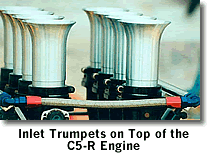 The Motorola Cup consists of two classes of basically improved showroom stock cars, a GT division with Corvettes, Acura NSXs, Saleen Mustangs and a gaggle of Porsche 911s, and a sport compact division with Acura Integras, Hondas, Maximas, etc.
The Motorola Cup consists of two classes of basically improved showroom stock cars, a GT division with Corvettes, Acura NSXs, Saleen Mustangs and a gaggle of Porsche 911s, and a sport compact division with Acura Integras, Hondas, Maximas, etc.
We were treated to an afternoon of first round qualifying for all classes for the Rolex 24 Hours, and the conditions were downright dodgy. The rain had been spitting and had gotten the track just wet enough to cause a decision to be made between wets or dry tires, but as the session went on, the racing line dried and the cars that had switched early to dry tires, definitely had the advantage. The Corvettes showed good form right out of the box and both cars were in the top 15. Since they race in the GTS class against Porsche 911 Turbos, and other production based sports cars, they really were not competing with the open cockpit, exotic Sports Prototype cars, but were faster than several of them.
I should probably do a quick run down of whom all is on the track together racing for the overall win, and for their class win. The slowest class of cars is call AGT, the "A" designates American. These cars are essentially tube frame, fiberglass body, carbureted V8 Camaros, Firebirds, Mustangs and a few scattered Corvettes most of the entries started their lives at cars in the SCCA B.F. Goodrich Trans Am Series.
The next class up the ladder is the GT class and includes normally aspirated 911s, BMW M3s, Ferrari 355 and 348 and a few other entries. These cars are very much production based, but have safety and performance enhancements.
The next class is GTS, which the factory Corvettes races in. These racecars are purpose-built cars, containing a little more exotic materials, like carbon fiber, and the class includes the Corvette C5R, the Porsche factory GT1 car (built for LeMans), Porsche 911 Turbos, and some other exotic car entries.
The two classes are both SR or Sports Racer classes. This means that they are open cockpit, primarily rear engine, stressed member cars, that are full-blown racing cars. They are descendants of the old prototype classes and Can Am series. These involve both designating a chassis and engine, which are very diverse. They include the awesome Ferrari 333SP, the Riley & Scott, and a newcomer, Crawford. The top level cars are powered by V8 Fords, V10 Judds, and V12 Ferraris, which at full tilt boogie will make the hair on the back of your neck stand up from the scream!
Just below the SRP is the SRPII, or Sports Racer Prototype II or Lights. These cars are slightly smaller, have smaller engines, but are still very impressive machines, but currently and expansion class with only two chassis manufacturers, Lola and newcomer Pilbeam, and they are all powered by a V6, stock based Nissan engine.
Our last treat of the day was Night Practice for all Rolex 24 competitors. It was such a wonderful sight to see these brightly colored, and blindingly fast cars running under the lights on the oval portion and then disappear into the darkness of the infield. We were getting a preview of what Saturday night would feel like. A constant din of various types of horsepower (about 40,000 horsepower), and the more subtle sounds of air wrenches practicing pit stops, a track announcer attempting to talk over the thunder, and conversations, flashbulbs, flags and signs lit, everywhere.
The best comparison of the unique atmosphere was if they had set up a state fair full of food, rides, people and smells next the night bombing of Baghdad. There was a war raging on the track, and we were there to see it all.
What a spectacular first day, and it went by so quickly. We checked into our hotel, The Treasure Island Inn (don’t laugh, just about everything there on the beach is tacky) and dove off to a quick dinner at Steve’s Famous Diner. Cars were still ringing in our ears.
Friday Morning
We decided to give ourselves a break since we knew we would be staying at the track all Saturday night, and did not go to the track at O’dark thirty, and headed in late morning, in plenty of time to get there for second round qualifying. Once again, on the way in we lost count of Porsches, Corvettes and even a handful of Ferraris. Just in the parking lot of our hotel we spied a 1990 red on red ZR1, and a 1991 red on tan Ferrari 348, plus a pile of rental cars a sure sign that a race is in town!
The track was rarely quiet, and we liked it that way. Friday was nice and laid back in comparison to Thursday. Well, at least for us spectators. The teams were hustling around quite a bit, but I noticed a theme that kept playing out over and over again pace yourself.
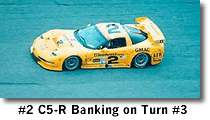 I spent three seasons on the CART FedEx Championship Series circuit and it was a constant thrash of travel, preparation, sponsorship hustle, media frenzy and tons and tons of fans. In comparison, the Gran Am crowd seemed to realize that this was the first race a season, a 24 hour event, and to just take your time and spend all of your efforts on finishing as well as you and lady luck would allow.
I spent three seasons on the CART FedEx Championship Series circuit and it was a constant thrash of travel, preparation, sponsorship hustle, media frenzy and tons and tons of fans. In comparison, the Gran Am crowd seemed to realize that this was the first race a season, a 24 hour event, and to just take your time and spend all of your efforts on finishing as well as you and lady luck would allow.
More picture taking, informal and formal meetings, lots of eating at the concession stands, and of course second round qualifying highlighting Friday. There really was not much build up. It was more like a quiet echo to distant thunder than a clap of lightning in your lap like an F1 or Champ Car race. The Risi Ferrari team had gone fast enough by the end of first round qualifying and did not even take the track on Friday. Pretty impressive.
Another impression of this massive event was all of the people from various forms of racing that all converged on Daytona for this journey twice around the clock. We saw many mechanics from CART and IRL, drivers from Europe, Japan and Australia just to name a few of the 30 countries represented, and officials from NASCAR, and the SCCA. Plus the three Winston Cup drivers, the aforementioned Earnhardt duo and Kyle Petty with a Porsche team.
We left the track around dinner time, did a quick change at the hotel, gawk at the cars in the lot again, and then we were off to a wonderful dinner at a local steak house, Angus Steaks. After some a nice filet, great service, and dessert, we were ready for the big day.
From my room I could hear the ocean, but more importantly the roar of engines was still ringing. The scream of the Ferrari and the ground shaking rumble and roar of the seven liter Corvettes.
Saturday
A miracle happened over night. Thousands and thousands of race fans had some and filled the infield to the absolute brim with cars, campers, pick up trucks, RVs and tents. The area between NASCAR 3 and 4 was absolutely packed. But we managed to back our rent-a-wreck into a space right next to a concession stand (very strategic), and we were facing directly into the racetrack. Perfect.
We did our lap of the garages to watch final preparations, wished some folks good luck, and then joined the throng of fans headed for the outside of the track, through the tunnel, to get to the grandstand. We climbed and climbed the stand until we popped out at the highest point we could get with general admission tickets, right below the press box at the start/finish line. What an incredible view. From here you can literally see the entire track.
The cars sitting in the pit lane, all gridded in starting order and ready to go, were actually obscured from view by the throng of fans, media and crew members assembled to get an up close look at the road warriors.
Jackie Stewart was the grand marshall of the event, and spoke to the crowd on the public address, and after the invocation, the national anthem, and some presentations, the magic words had finally come.
 "Gentlemen. Start your engines!"
"Gentlemen. Start your engines!"
The grid was cleared, the earth was shaking and the crowd was standing. The beautiful pair of Corvette C5R pace cars led the enormous field of 89 cars of on the first of two warm up laps, and the entire field took up the length of the infield road course section of the track. It was over twice as many cars that will take the flag at the Daytona 500.
The laps went by quickly, and at the stroke of 1:00 p.m. EST, on the large Rolex clock in the pit lane, the field accelerated to the green flag, and the grandstands rumbled under our feet to the sound of 45,000 horsepower.
For the first hour, you would think that the race was only two hours long, with the dicing and passing, and sprint pace, but little did we know that this was business as usual. Lap after amazing lap of two and three wide racing, the many classes of cars, and individual sounds, began to blend into one mighty and constant chord. A chord that would not stop for 24 hours straight.
Hour after hour, and lap after lap, the battle raged. And there seemed to be a constant stream of cars in and out of the pit lane for service and a trickle in and out of the garages for repairs. We began to wander back to the infield, and stopped at the complementary wine and cheese tasting free to anyone with a ticket! Wonderful selection, a Formula One car on display, racing art and a jazz band in a tent on the infield of the Rolex 24 outstanding!
There was also a car auction taking place, a rock stage with bands, and the vendors. And in the background, that constant chord.
 Then the rain came, and we figured that it would thin the crowd and slow the pace. Not at all. The hammering went on with little to no let up in intensity, and the fans here were not the meek type. Plastic coats and umbrellas appeared and time marched on.
Then the rain came, and we figured that it would thin the crowd and slow the pace. Not at all. The hammering went on with little to no let up in intensity, and the fans here were not the meek type. Plastic coats and umbrellas appeared and time marched on.
After wandering back to the car for a quick nap, we went back to the pitlane for the next six hours. And time for us flew by, making conversation with mechanics and crew members, watching pit stops and driver changes, and sampling the gourmet coffee stand and other food vendors.
We had to give in to sleep at about 2:00 a.m., and reclined the rental car seats and drifted in and out of sleep for a few hours. But I will never forget what it was like to wake up at 3:30 a.m., and peer through a rain soaked windscreen at a brightly lit track of cars, flying by at over 150 miles per hour. A few outlines of hearty souls would walk by, but the camp had gone quiet, except for that constant chord of V8s, V6s, V10s and V12s ripping through the night.
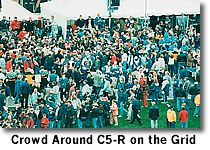 At six, it was time to stir and see who made it through the night. Over 30 cars had dropped out since midnight in the brutal pace. But very few caution periods had occurred, which is a testament to the professionalism and focus that is required for this event.
At six, it was time to stir and see who made it through the night. Over 30 cars had dropped out since midnight in the brutal pace. But very few caution periods had occurred, which is a testament to the professionalism and focus that is required for this event.
We made a mad dash to our hotel to shower and check out, and throw some gas in the rental, and made it back in under an hour, this time parking on the outside of the track to avoid the crush through the tunnel after the checkered flag.
Breakfast at the concession stands, which had stayed open all night, and then up to the grandstand to watch the last few hours of this amazing event.
That old theme of pacing yourself was now showing us its wisdom. A GTS car was leading a Corvette! The Sports Racing Prototypes had run into trouble over night and even though most of them were faster and had built up large leads, had to be sidelined and watched their leads dwindle and then vanish to the cars that could simply be reliable. And a GT car was second! Amazing.
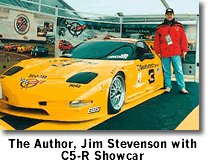 The C5R was actually limping badly with a crook gearbox, and with 15 minutes left on the clock, came into the pits with an insurmountable lead of 15 laps on the next car. The number 2 Corvette even took pictures together, did all of the hand shaking, and then took the car out for two final laps as the clock struck 1:00, and the two Corvettes finished side by side on the track, and first and fourth overall.
The C5R was actually limping badly with a crook gearbox, and with 15 minutes left on the clock, came into the pits with an insurmountable lead of 15 laps on the next car. The number 2 Corvette even took pictures together, did all of the hand shaking, and then took the car out for two final laps as the clock struck 1:00, and the two Corvettes finished side by side on the track, and first and fourth overall.
Our exit of the track was a blur and the flights home simply routine, but it took me days to actually soak in everything that I saw, and I am still somewhat in disbelief that over half of the field raced. And race hard twice around the clock and covered the distance from New York to L.A. in brutal day.
I will never say 24 hours lightly, without remembering just how long and brutal it can be.
(Special thanks to Bobby Brown, owner and driver of the Number 2, Brown Motorsports Ferrari 333SP who arranged our credentials and Bobby we are going for the win next year.)
Jim Stevenson
Partner in Formula Marketing, LLC
Corvette owner (1978 black on red, four speed)

